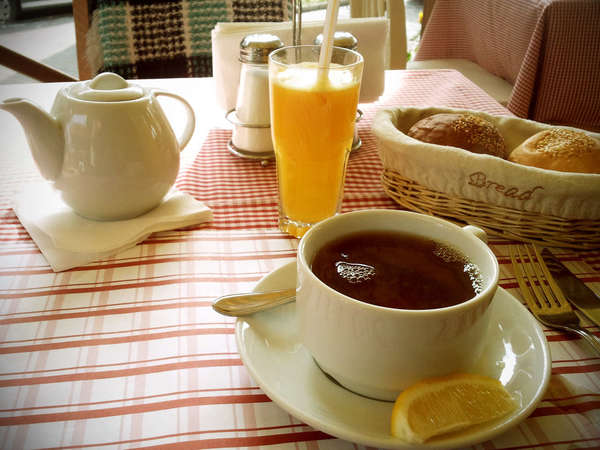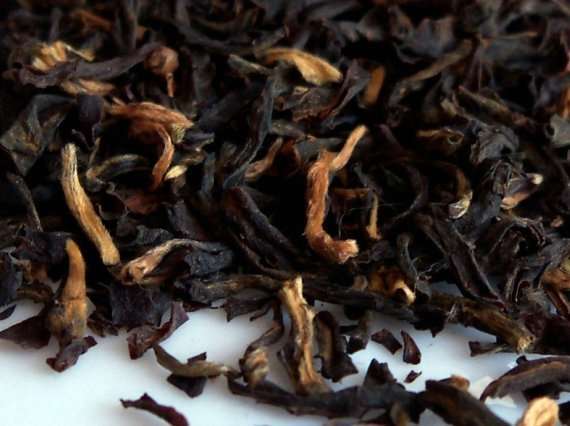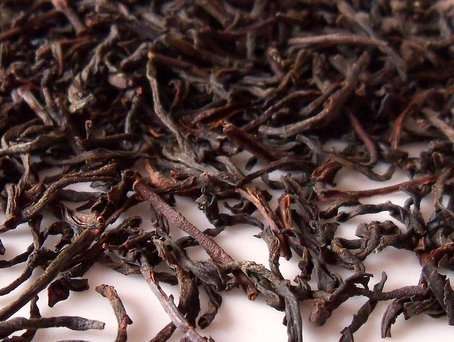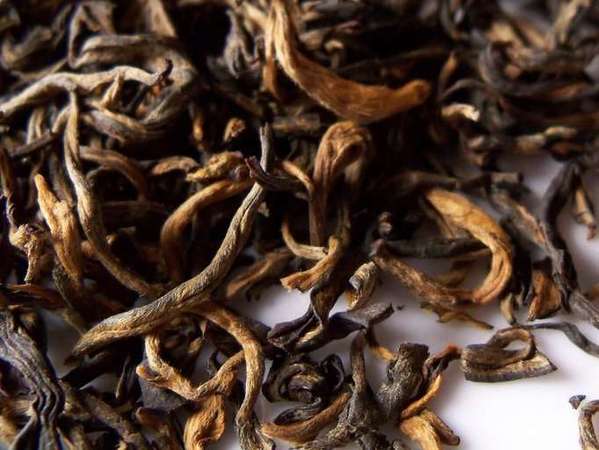Breakfast Teas
Last Updated: Nov. 8, 2011
 Black Tea with Breakfast, © Aurelian Săndulescu (:, CC BY 2.0.
Black Tea with Breakfast, © Aurelian Săndulescu (:, CC BY 2.0.Breakfast teas provide both a higher caffeine content and a robust flavor that can hold its own against rich or heavy foods. Often, these teas are drunk with milk and/or sugar, and accordingly, they must be strong enough to hold their flavor even when milk is added. This contrasts with lighter black teas like Darjeeling, often served with afternoon tea. Breakfast teas are usually (but not always) blends of black teas from different regions.
 Leaf of Kensington Premium English Breakfast Black Tea from American Tea Room, © A Girl With Tea, CC BY 2.0.
Leaf of Kensington Premium English Breakfast Black Tea from American Tea Room, © A Girl With Tea, CC BY 2.0.Different styles of breakfast tea
The most widely-known style of breakfast tea is English Breakfast, and the second most common is Irish Breakfast, but these terms are used primarily in the U.S.; in the UK and Ireland, people refer to their breakfast tea just as tea. English Breakfast is a strong tea, but Irish Breakfast is usually stronger. Less common and less well-defined but still important as a style of its own is Scottish Breakfast. Scottish Breakfast is another similar strong style of black tea blend, which is sometimes (but not always) smoky or woody in flavor. The smoky character in this tea is achieved by including Lapsang souchong or a similar tea, which is dried over wood smoke, imparting a smoky or woody quality to the tea.There are also other black tea blends which fit with the style of breakfast teas, such as Ostfreisentee or East Frisian tea, a strong black tea blend that originated in East Frisia, a region along the north coast of Germany. There are a number of strong breakfast blends originating in Russia as well, but the term "Russian breakfast" is not in common use.
The term Chinese Breakfast is sometimes used to refer to black teas of Chinese origin which have a robust flavor reminiscent of most breakfast teas, such as those from Yunnan province. However, this tea is not widely accepted as a style of its own, and it is also distinct from English and Irish breakfast blends in that it is a term used primarily for marketing purposes in Western countries, and does not refer to a style traditionally consumed in China the way English and Irish Breakfast reflect the actual tea culture of England and Ireland.
What specific teas are used in breakfast blends?
 Ceylon is a common ingredient in breakfast blends. Photo © A Girl With Tea, CC BY 2.0.
Ceylon is a common ingredient in breakfast blends. Photo © A Girl With Tea, CC BY 2.0.Irish Breakfast in particular often contains a large portion of Assam, and is sometimes made exclusively from Assam. Kenyan teas and other African teas also tend to have a strong flavor and are also common ingredients in breakfast blends. Ceylon tea and Yunnan black tea are both other common ingredients. Less common, but still used, are Keemun and other Chinese black teas. Lighter black teas with a more high-grown character, such as Darjeeling and other teas from the Himalayan region, are less commonly included.
If you want to buy single-region tea that has the character or style of a typical breakfast tea, teas from these regions, particularly Assam, Yunnan, Kenya, and Sri Lanka (Ceylon) are good places to start.
C.T.C. (Crush-tear-curl) teas
Breakfast teas are often made out of C.T.C. (Crush-tear-curl) tea, made by a mechanical production process, in contrast with orthodox tea, produced by traditional, manual processing methods. Although C.T.C. tea is often viewed as inferior by tea connoisseurs, and although the C.T.C. method was invented as a cost-saving technique, C.T.C. tea is sometimes favored in breakfast blends because it infuses quickly, leading to a strong, robust cup. But many of the higher-quality breakfast blends are made from orthodox tea as well. Tippy teas like this Yunnan tea contain more caffeine, making them popular in higher-end breakfast blends. Photo © A Girl With Tea, CC BY 2.0.
Tippy teas like this Yunnan tea contain more caffeine, making them popular in higher-end breakfast blends. Photo © A Girl With Tea, CC BY 2.0.Tippy teas
Tippy teas, teas containing a greater portion of tips and leaf buds, are often favorite ingredients in breakfast teas, as they have a higher caffeine content than teas made out of older, more mature leaves of the tea plant. More on this topic can be found on the page on the caffeine content of various teas. Among black teas, the tips tend to have a golden color, so tippy teas will tend to have golden tips visible in the leaf; some teas, such as yunnan gold, can me made mostly or exclusively of tips, giving them a more golden than black color as a whole.In summary
Breakfast teas are an important part of Western tea culture, especially that of the UK and Ireland, where they are referred to just as "tea". However, tea culture is currently undergoing a great diversification as green, oolong, and other teas are becoming more widely populary. Many people prefer to drink green or other teas for breakfast, and some people prefer drinking strong black teas at other times of the day. Explore the world of tea for yourself, and decide on your own which teas you like most with your breakfast.References
1. Emily Han, What's the Difference Between English, Irish and Scottish Breakfast Teas?, Kitchn, Apr 7, 2014.

